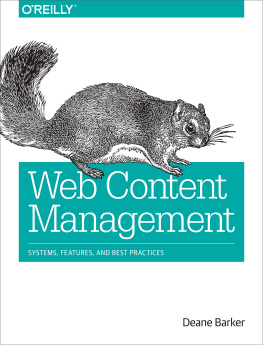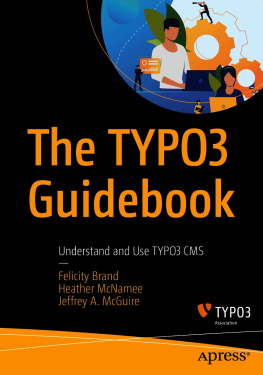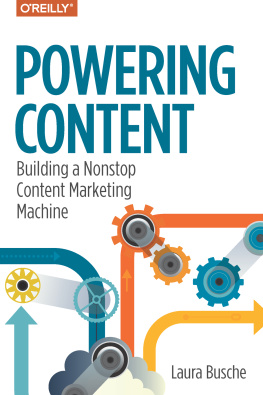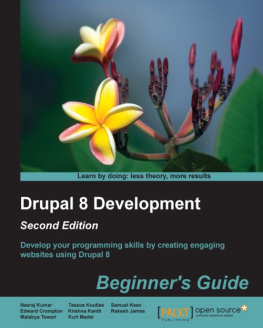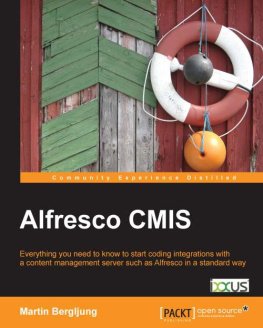For Mom.
I finally figured out what I want to be when I grow up.
Foreword
The web content management industry has evolved substantially over the past two decades. Today, CMS vendors and industry pundits put overarching emphasis on customer experience management, the idea that successful customer interactions should drive all your digital investments. This is a useful prioritization, inasmuch as we should all be thinking screen first (i.e., how do customers experience our digital incarnations?) After all, why produce digital content unless people actually want to consume it?
But this emphasis on experience management sometimes relegates the process of producing and publishing high-quality information to the backseat. We can all understand why marketers pay more attention to frontend design, mobile strategies, and social micromessaging, but in doing so they risk losing focus on deeper forms of information-based engagement.
Consider the nearly ubiquitous desire to create more personalized digital interactions. Many personalization strategies start with the premise, assume suitable content for each interaction. This begs many questions. Suitable content from where? How will it be managed? How will it get chunked? How will we vary it for each and every audience? How will it get assembled? How will we simulate all the permutations? Behind those questions lie some thorny content management challenges.
On the brighter side, the last few years have seen the rise of content strategy as an important digital discipline. What exactly people mean by content strategy will vary, but the general idea is that you need to have your content house in order before you start executing business strategies across various digital channels.
The emergence of a new generation of digital content strategists is a welcome development, though I sometimes wish they would better understand the organizational environments where their strategies need to live. Content strategies that look great on day 1 can get messy by day 365, let alone day 730. You need to sort out simple authoring and approval regimes; you need to find and modify previous versions of campaigns; you need to integrate analytics into subsequent iterations; you need to archive older information so it doesnt clog up your search engine results. And so on.
So, the WCM industry is experiencing some key gaps today, and we need people who can effectively bridge those gaps. Like the gap between content creation and content consumption. The gap between content strategies and CMS implementations. Between business needs and architectural patterns. Between authors and marketers. Between developers and campaign managers. Between strategists and implementers. Deane Barker is the rare individual who can speak to all those concerns.
As a New Zealander happily transplanted to North America, Deane has the ability to get passionately engaged yet also take the outsiders critical perspective. At first blush this book is a primer on essential CMS topics, but when you read more deeply youll find its really an argumenta passionate call to treat web content and processes around it as seriously as you treat any other business or marketing asset.
So, you should read the book cover to cover, but I particularly recommend you bookmark the chapters on the CMS team, content modeling and aggregation, migration, and implementation. These are the tough topics that consultants and vendors often dont like to discuss, but that could make or break your CMS program. Deane covers them with the right mix of breadth and efficiency that can only come from someone whos gone through them many, many times.
Although this book is written for the business generalist, if you are a developer or architect its a very worthwhile read, and would have been even if Deane hadnt included all the useful code snippets (though he did include them, to my delight and hopefully yours). Check out the early chapter on points of comparison for some key logical distinctions youll want your team to follow.
If there was a magical machine that could make the perfect CMS, I would put Deane at the controls. In the absence of such a machine, the rest of us need to figure out best practices the old-fashioned way: by testing and experience. I hope you get the chance to test many CMS tools, just to get a firsthand feel for the surprising variations in approach among them. But if you are looking for a single source of received wisdom and experience on CMS best practices, then drop what youre doing and read this book.
Tony Byrne
Founder, Real Story Group
www.realstorygroup.com
December 2015
Preface
Back in 1995 or so, I wrote my first HTML document.
I wrote it in Notepad on my 90 MHz Pentium tower from Gateway 2000. I still remember adding a TITLE tag, refreshing the page in Internet Explorer, and watching with awe as my document title filled the title bar of the browser window (the idea of tabbed browsers was still years in the future, so the documents TITLE tag became the title of the entire window).
That first web page quickly grew into an entire website (the subject and point of which I honestly cant rememberI suspect it was just a list of links to other sites). Mainstream adoption of CSS and JavaScript was still a few years off, so I didnt have scripts or stylesheets, but I had a handful of HTML files and a bunch of images (you were nobody if you didnt have a tiled, textured background on your page of links).
Quickly, I ran smack into the first problem of webmasters everywhere: how do I keep track of all this stuff? I dont even think the word content had been popularly applied yetit was all just stuff.
As websites inevitably grew, so did all the stuff. Since we were largely bound to the filesystem, we had copies of everything on our local computers that we would FTP to our servers. Huge problems resulted if you had more than one editor. With two people trying to manage files, they would inevitably get out of sync and changes would be unintentionally overwritten. Occasionally, you had to sync against the server by downloading everything and overwriting your local copy, just to make sure you had the latest version of the entire site.

